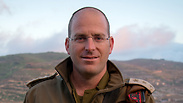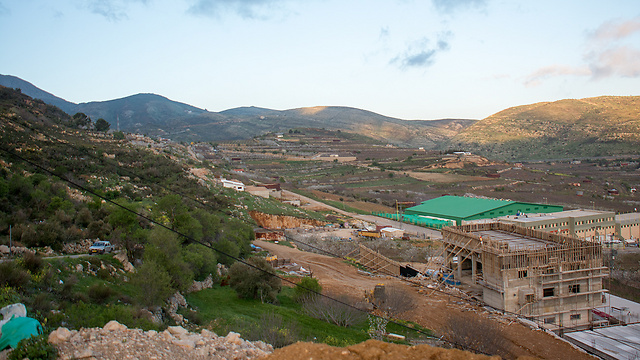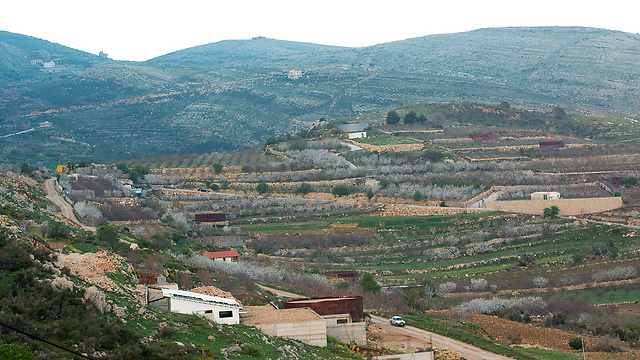
Colonel Avinoam Stolovitz at his post on Mount Hermon. (Photo: IDF Spokesman's Unit)
Colonel Avinoam Stolovitz. (Photo: IDF Spokesman Unit)
Inside look: Commanding an area bordering al-Qaeda, Hezbollah and Syrian commandos
At his outpost at the summit of Israel's highest peak on Mount Hermon, Brigade Commander Colonel Avinoam Stolovitz has a bird's-eye-view of one of Israel's most complex borders which rubs elbows with several enemy forces in the region.
From the highest point in Israel, the skyscrapers of Damascus are clearly visible through the pillar of a cloud and they deceivingly convey peacefulness. Mount Hermon, 2,223 meters above the ground, measuring at 4 degrees Celsius at five pm in the afternoon was expected to receive snow and a thick cloud envelopes the Israeli summit - which makes up only 7 percent of the mythical mountain ridge.
This is the only spot on Mount Hermon where remnants of snow can still be spotted because of the temperatures measuring close to zero degrees Celsius. And then, for a few magical moments, the cloud dissipates.
We stand at the ledge outside this post and this is – more or less – the border with Syria.
Beyond the ledge is a green expansion in the horizon on the true peaks of the Hermon mountain – that that are on the Syrian side.
The village of Beit Janin, and after it the plow of the larger town of Beit Jann, are embedded in the valley just a few hundred meters away.
The spectacle is reminiscent of the Shire Valley in Lord of the Rings.
In reality it is President Bashar Assad's last stronghold in the Syrian Golan Heights, and most critical – yet to be captured by the Syrian rebels.
"And they are there – hundreds of armed rebels, in the villages you see right now, fighting in order conquer the two army bases manned by the Syrian army – the last two that he has left in the Golan," says Hermon Brigade Commander Colonel Avinoam Stolovitz.
"Sometimes we can really see the mortal shell firings in the shape of a rainbow, from the lookouts into the villages," says the colonel.
Assad lost 80 percent of the border strip with Israel, from the Hamat Gader hot springs site in the Yarmouk River valley up until Mount Hermon. But just like the IDF in the Yom Kippur War, the Syrian army insists on fighting until the last minute for the high strategic stronghold from which it controls the observation and firing on the IDF post.
But this is not the reason for the looming battle. The minute the Hermon falls into the hands of the Syrian rebels, the rest of the southern entryway into Lebanon from Syria will be at their fingertips, and only the hidden Hezbollah position in Jebel al-Ras – the Lebanese portion of the Hermon – will separate the rebels from conquering territory in the land of the Cedars.
The rebels are taking advantage of almost every free moment to prepare for fighting and the IDF's observation cameras have recorded their training to takeover the military outpost in the past two months, close to the border with Israel.
Video footage of the training session was first exposed on Ynet and the IDF could not confirm whether the training was mean to prepare for taking over a Syrian or Israeli military outpost.
Syrian rebels training in Golan Heights. (צילום: דובר צה"ל)
Al-Qaeda or Assad?
Just like in the Qalamun Mountains, north of Israel, Assad is also investing a supreme effort at Mount Hermon. Both sides experienced a harsh winter, and the fear is that the upcoming summer, which will melt the snow, will accelerate the fighting at the Hermon and maybe even determine it.That is to say there are two possibilities: The Syrian rebels, interlaced with al-Qaeda and the Islamic State group, could overtake the Syrian side of the Hermon or the Syrian army could be strengthened by Hezbollah fighters and Revolutionary Guard fighters.
Both possibilities are not encouraging as with the improvement in weather, the movement of arms smugglers and refugees from Syria and Lebanon is expected to strengthen – right under Israel's posts.
The battle over the Hermon as the potential to dramatically impact the Israeli side of the mountain as well, and maybe even the entire northern border.
In front of all of this chaos stands Colonel Stolovitz – not stereotypical, he is a man of restraint who feels like a chess player who is facing several opponents at the same time and trying to think a few steps forward.
"If you approach the situation with the typical protection methods at the Hermon, that have been implemented for years, such as opening roads at regular hours, you produce something that does not fit the current enemy," says Colonel Stolovitz.
"The change in our operations is big. The alpinists conducted an operational employment that last three months in a row, and they, as veterans and experts in the field, said that they felt as though the army opened here different possibilities than ever before," says the colonel.
Colonel Stolovitz has become the only brigade commander in the IDF to confront the borders of two enemy countries, and within them a multitude of different arms forces. "The unit must think about facing Hezbollah at any given time, (along with) the Syrian commandos, the Iranian proxies and with global jihadists. We must think several steps forward," says Colonel Stolovitz.
Hezbollah meddling with three borders
The regional brigade commanded by Colonel Stolovitz has been able to maintain a relative clam, even on days when there are multiple hikers on the mountain, although hikers were evacuated from the Hermon twice this past winter and four incidents involving rocket fire were launched at the Israeli side of the mountain – all of which caused no damage or injuries.The challenge to deal with the turmoil on the other side of the border becomes even more difficult in the absence of a physical barrier in most part of the area. Other than in the lower branch of the mountain, close to Majdal Shams, there is no security fence because of the difficult mountain terrain.
"In the few places there is a fence at the summit of the mountain it falls apart again and again in the winter under the weight of the snow that amounts on it. Therefore, we strengthened the barrier with advanced intelligence gathering; we added radars and cameras and changed the patterns of activity. We brought up some tanks to some of the outposts on the mountain as a preparation for battle, we improved the coordination and the availability of assault helicopters and the Air Force in the event we need them quickly," says Colonel Stolovitz.
On the eastern slopes of Mount Hermon the picture begins to change. At the flattest part of the border, with Majdal Shams in the south, which is also under the jurisdiction of the unit, the picture is even more complicated.
Two UNDOF (United Nations Disengagement Observer Force) outposts on the Syrian side of the border, right near the Israeli town of Majdal Shams, were abandoned by UN forces – and there is fear of a similar trend at the summit of the mountain.
"We are following (the events) and will know how to act if these UN positions will be captured by radical groups," says Colonel Stolovitz. "In the meantime, we are working so that the UN will stay and be strong enough, because today it is hard to be assisted without UNDOF."
When asked to what extend he is satisfied with the IDF's intelligence gathering on the other side of the border, Colonel Stolovitz says: "The intelligence gives us a lot, and we were not surprised by the events that took place here, but I am preparing the forces for an attack with no warning in advance, so that even if we are surprised we will not be defeated. Hezbollah is meddling at these triangular borders, and it is not for nothing that it recently declared that it is the entrance gate to Lebanon."


















